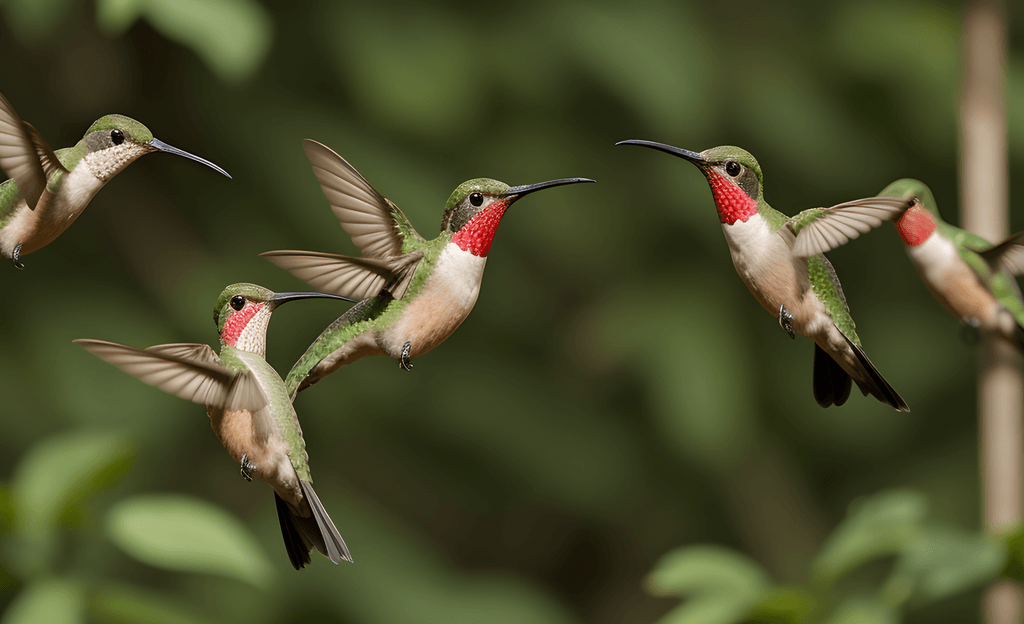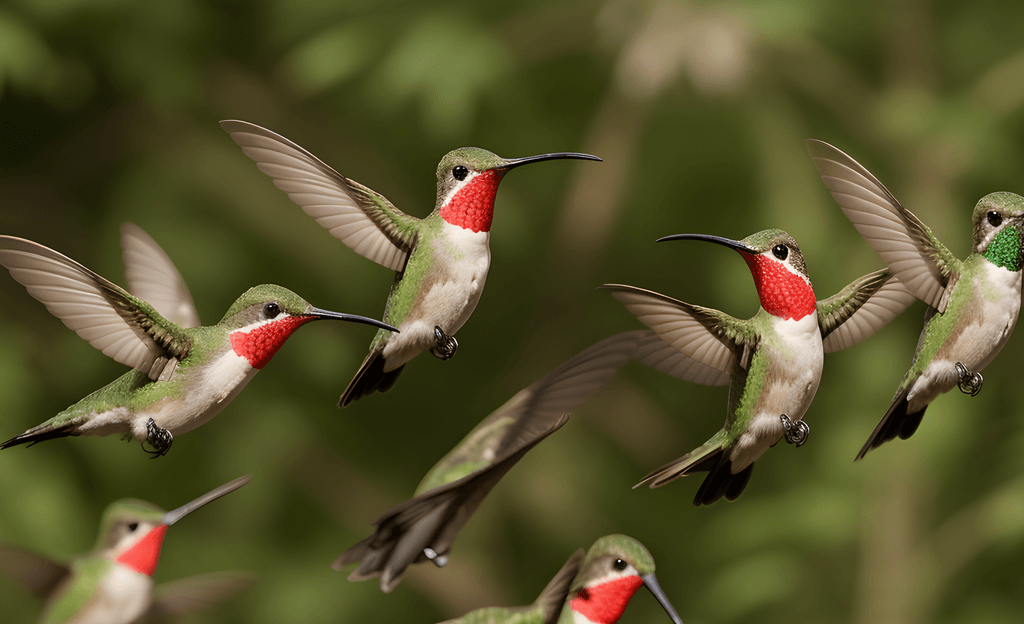Key Takeaways
- Understanding Hummingbird Behavior: Hummingbirds, or hummers, may exhibit aggressive behavior towards humans in certain situations, but it is usually a defense mechanism rather than an attack.
- Hummingbirds can be territorial and may display aggression towards other birds or animals that enter their space.
- Identifying Aggressiveness: Some hummingbird species are more aggressive than others, such as the Rufous Hummingbird, known for its territorial behavior.
- Approaching Humans: Hummingbirds may approach humans out of curiosity, especially if they associate humans with food sources like nectar feeders.
- Preventing Bites: To avoid hummingbird bites, maintain a safe distance and refrain from trying to touch or handle these delicate birds.
- Recognizing Distress Signals Signs of distress in hummingbirds, like rapid breathing or lethargy, indicate potential health issues and require attention.
Introduction
Hummingbirds, those tiny creatures that feed on nectar, with iridescent feathers and lightning-fast wings, are a wonder of nature. But have you ever wondered if these delicate birds can be aggressive towards humans? Let’s delve into the intriguing question: do hummingbirds attack humans? While these charming birds may seem harmless as they flit around flowers and feeders, there are instances where they display territorial behavior that might surprise you. Understanding the historical context of interactions between hummingbirds and humans can shed light on this fascinating topic.
Do Hummingbirds Attack Humans?
Curious Nature
Hummingbirds, known for their vibrant colors and remarkable agility, are curious creatures that are often attracted to feeders. They often display inquisitive behavior towards humans and may approach them out of curiosity. These tiny birds are not afraid to explore their surroundings, including interacting with people.
Hummingbirds’ curiosity can lead them to investigate anything new or interesting in their environment – this includes humans. Their boldness is evident when they fly close to individuals, sometimes hovering near a person’s face or even perching on an outstretched finger. This behavior showcases the friendly and fearless nature of these fascinating birds.
Friendly Interactions
Despite their small size and delicate appearance, hummingbirds can exhibit surprisingly friendly behaviors towards humans. In some instances, these birds have been observed flying very close to people without any signs of aggression or fear. Such interactions demonstrate the gentle demeanor that hummingbirds can display when approaching people.
When a hummingbird approaches a human with no intention of harm but rather out of sheer curiosity or friendliness, it creates a unique moment where the beauty of wildlife connects with our own world. These interactions serve as reminders of how harmoniously we can coexist with nature’s creations like the charming hummers.
Interactions Between Hummingbirds and Other Species
Competition for Resources
Hummingbirds share their habitats with various species, leading to interactions such as competition for food. These tiny birds fiercely defend their food supply, often engaging in territorial disputes with other bird species. For example, larger birds might try to dominate a feeder area, causing hummingbirds to fight back.
Some birds may even mimic the appearance or behavior of hummingbirds to access resources easily. This competitive nature among different bird species can sometimes lead to conflicts over flowers or feeding stations. Despite their small size, hummingbirds are known for their tenacity.
Symbiotic Relationships
While some interactions involve competition, others result in symbiotic relationships between hummingbirds and other creatures. Certain plants rely on hummingbirds for pollination due to their unique feeding habits that promote cross-pollination. In return, these flowers provide a vital food source for the hummers while ensuring the plant’s reproduction through pollen transfer.
In some cases, certain bird species act as “cleaners” by removing parasites from hummingbird feathers or skin when they visit the same areas. This mutually beneficial relationship helps both parties: the cleaner birds get an easy meal while helping keep the hummingbird healthy and parasite-free.
Aggressiveness of Hummingbirds
Defensive Behavior
Hummingbirds are known for their aggression towards perceived threats. They fiercely protect their territory, including food sources and nesting sites. These tiny birds may dive-bomb or chase away intruders, including other hummingbirds and even larger species.
Despite their small size—ranging from 2 to 8 inches—hummingbirds exhibit remarkable fighting skills when defending what they consider theirs. Their territorial behavior is crucial for survival in the wild, ensuring they have access to essential resources like nectar and insects.
I find it fascinating how such small creatures can display such boldness in defending themselves against potential dangers. Personally, observing hummingbirds engage in these defensive behaviors adds an exciting element to birdwatching activities.

Common Trait
Aggression is a common trait among hummingbird species worldwide. This behavior is not limited to specific regions or types of hummingbirds; rather, it’s a universal characteristic shared by these remarkable birds. The level of aggression varies among individual birds and species.
The aggressive nature of hummingbirds plays a vital role in their survival strategy by allowing them to establish and maintain territories that provide necessary resources for sustenance and breeding. This behavior ensures that each bird has ample access to food sources without competition from others.
- Pros:
- Helps hummingbirds secure essential resources.
- Ensures individual survival through territorial defense.
- Cons:
- Aggressive behavior can lead to injuries during confrontations.
- May deter other bird species from sharing the same habitat.
Most Aggressive Hummingbird Species
Rufous Hummingbird
The Rufous hummingbird is renowned for its aggressive behavior, often engaging in territorial disputes with other birds. These tiny creatures fiercely defend their feeding areas and are not afraid to confront larger species. Their bold nature can lead them to chase away intruders, including humans who come too close.
Hummingbirds like the Rufous are known to dive-bomb perceived threats relentlessly until they retreat. This behavior may seem intimidating, but it’s essential for their survival in the wild. Understanding this aggression helps us appreciate these birds’ unique characteristics better.
Behavior Analysis
Observing hummingbirds’ behaviors provides valuable insights into how different species interact with each other and their environment. By studying their actions, researchers can uncover patterns related to breeding habits, migration routes, and territorial defense mechanisms. This knowledge aids conservation efforts by identifying critical habitats that need protection.
Learning about the various hummingbird species’ aggressiveness allows bird enthusiasts to create welcoming environments without disturbing these delicate creatures unnecessarily.
Reasons for Hummingbirds Approaching Humans
Mistaking Bright Clothing
Hummingbirds may mistake bright clothing worn by humans for flowers. Their keen eyesight is attracted to vibrant colors, especially shades of red and pink. When a hummingbird spots these colors, it might fly closer, thinking it has found a food source.
When wearing bright colors like red or pink outdoors, you may inadvertently attract hummingbirds due to their association of these hues with flowers. This can lead to delightful encounters as the tiny birds flit around you in search of nectar-like substances.
Human Voices Attraction
The sound of human voices can also draw hummingbirds near. These small creatures are curious and may investigate any new or unusual sounds they hear. Therefore, talking softly or making gentle noises could pique their interest and bring them closer for observation.
If you enjoy spending time in your garden observing wildlife, try softly speaking or making calming sounds while keeping still. You might find that this attracts hummingbirds seeking to investigate the unfamiliar noise source nearby.
Offering Food Incentives
One effective way to encourage hummingbirds to approach humans is by offering them food sources such as sugar water in feeders or planting nectar-producing flowers in your yard. By providing easily accessible nourishment, you create an inviting environment that entices these birds to come closer.
Setting up bird feeders filled with sugar water solution can be an excellent way to invite hummingbirds into your outdoor space for close-up viewing opportunities. Cultivating a garden with plants like bee balm or trumpet vine can provide natural food sources that attract these fascinating creatures.
Understanding Hummingbird Bites
Rare Occurrence
Hummingbirds rarely bite humans, and when they do, it’s typically a form of defense. These tiny birds have very small teeth, which they use to grip onto branches or defend themselves if they feel threatened. The bites are not usually aggressive but more of a warning signal.
Despite their size, hummingbirds can be territorial during nesting season, leading to an increase in defensive behaviors like biting. It’s essential to understand that these bites are not meant to harm but rather as a way for the bird to protect itself or its territory. As such, it is crucial to respect their space and avoid provoking them.

Nesting Season Behavior
During nesting season, hummingbirds become more protective of their nests and young ones. This heightened sense of protection can lead them to exhibit defensive behaviors like biting. If you come across a hummingbird during this time, it is best to keep your distance and observe from afar without causing any disturbance.
It’s fascinating how these delicate creatures transform into fierce defenders. Personally, I find it remarkable how such tiny birds can display such strong maternal instincts despite their size.
Signs of Distress in Hummingbirds
Rapid Breathing and Lethargy
Hummingbirds, known for their energy and agility, can exhibit signs of distress through rapid breathing and lethargy. If you notice a hummingbird sitting puffed up for an extended period or breathing heavily, it might be under stress. These tiny creatures usually have fast heart rates but become even more pronounced when distressed.
When observing a hummingbird exhibiting rapid breathing or lethargy, consider the possible causes such as predator threats, injuries, or even issues related to its environment like extreme weather conditions. To help a distressed hummingbird, provide a safe space by keeping predators away and ensuring access to fresh nectar feeders.
Changes in Feeding Patterns
Changes in feeding patterns can also signal distress in hummingbirds. A sudden decrease in visits to your feeder could indicate that something is wrong with the bird. It’s essential to monitor their usual feeding routines closely; any deviations could mean they are experiencing difficulties.
If you notice changes in how often hummingbirds visit your feeder, take action promptly by assessing potential stressors around the area where they feed. Eliminate anything that may cause them discomfort or fear so that these beautiful birds feel secure enough to resume their regular feeding habits.
Observing and Responding
It’s crucial always to observe and respond promptly when noticing signs of distress in hummingbirds. These delicate creatures rely on our care and attention for survival; hence, being attentive can make a significant difference in their well-being. By responding quickly to indications of stress, we can help ensure these remarkable birds thrive despite the challenges they may face.
Habitat and Nesting Preferences of Hummingbirds
Nectar Sources
Hummingbirds are attracted to habitats with abundant nectar sources like flowering plants, which provide them with the energy they need. These tiny birds have a high metabolism and require frequent feeding to sustain their active lifestyle. By planting flowers such as bee balm, salvia, or fuchsia in your garden, you can create an environment that hummingbirds find irresistible.
I personally love watching hummingbirds flit from flower to flower in my backyard. It’s fascinating how these delicate creatures rely on nectar for survival. Providing a variety of nectar-rich flowers not only benefits the hummingbirds but also adds beauty to your outdoor space.
Nest Building
Hummingbirds exhibit remarkable craftsmanship by building intricate nests using plant materials and even spider silk for added flexibility. Their nests are often camouflaged with lichen or moss, making them blend seamlessly into their surroundings. Understanding where hummingbirds prefer to build their nests is crucial for conservation efforts.
Creating a suitable environment for nesting is essential in supporting the reproduction of these marvelous birds. I’ve learned that placing small containers filled with soft materials like cotton near your garden can assist female hummingbirds in gathering nest-building materials more conveniently.
Habitat Protection
Protecting the habitats where cedar waxwings reside is vital for ensuring their continued presence in our ecosystems. By preserving areas rich in pine trees or other vegetation that serve as ideal locations for nesting, we contribute to maintaining biodiversity and ecosystem balance.
Maintaining green spaces within urban environments plays a significant role in providing sanctuaries for various bird species like cedar waxwings. Planting native trees such as pines not only enhances the landscape but also attracts diverse wildlife populations seeking shelter and food sources.
Significance of Close Human-Hummingbird Encounters
Insights into Behavior
Close interactions between humans and hummingbirds offer valuable insights into hummingbird behavior. Observing these birds up close allows us to witness their unique characteristics, such as their rapid wing movements and hovering abilities. By studying them in proximity, researchers and bird enthusiasts can gain a deeper understanding of how hummingbirds navigate their environment and interact with other species.
Hummingbirds are known for their territorial nature, especially during the breeding season. Witnessing these behaviors firsthand can provide crucial information about how they establish and defend territories against intruders, including other hummingbirds or even larger birds. For example, observing aggressive behaviors like dive-bombing or vocalizations towards perceived threats sheds light on the complex social dynamics within hummingbird populations.

Fostering Appreciation
One of the key benefits of close human-hummingbird encounters is that they foster a greater appreciation for these tiny birds. When people have the opportunity to observe hummingbirds feeding, interacting with each other, or building nests nearby, it often sparks a sense of wonder and admiration for these remarkable creatures. This newfound appreciation can lead to increased conservation efforts aimed at protecting hummingbird habitats and ensuring their survival for future generations.
- Pros:
- Enhances understanding of hummingbird behavior.
- Sparks curiosity and admiration for these fascinating birds.
- Cons:
- May disrupt natural behaviors if not approached respectfully.
Closing Thoughts
Reflecting on the behavior of hummingbirds towards humans, it’s evident that these tiny creatures exhibit a range of interactions, from curiosity to aggression. Understanding their actions can help us appreciate the delicate balance between nature and human presence. As we marvel at their beauty and agility, it’s crucial to respect their space and needs.
Intrigued by the world of hummingbirds? Take a moment to observe them in your surroundings, appreciating their unique behaviors and the wonders of nature. Let’s strive to coexist harmoniously with these fascinating creatures, creating a sanctuary for them in our backyards. Together, we can nurture a shared environment where both humans and hummingbirds thrive.
Frequently Asked Questions
Can hummingbirds attack humans?
Hummingbirds are not known to intentionally attack humans. However, they may exhibit territorial behavior if they feel threatened or when protecting their nest. It’s rare for a hummingbird to physically harm a human.
Are there aggressive hummingbird species?
Yes, some hummingbird species are more aggressive than others. The Ruby-throated Hummingbird and Rufous Hummingbird are known to be among the most aggressive species, especially during breeding season or when defending their territory.
Do hummingbirds bite humans?
While extremely rare, hummingbirds can bite humans if they feel threatened or stressed. Their bites are not harmful but may startle you due to their small size and rapid movements.
How can I tell if a hummingbird is distressed?
Signs of distress in hummingbirds include rapid breathing, puffed-up feathers, lethargy, or staying in one spot for an extended period. If you notice these behaviors in a hummingbird near you, it might be experiencing stress.
Why do some people have close encounters with hummingbirds?
Hummingbirds may approach humans out of curiosity or mistaking bright-colored clothing for flowers. These close encounters offer unique opportunities to observe these fascinating creatures up close and appreciate their beauty from a different perspective.
